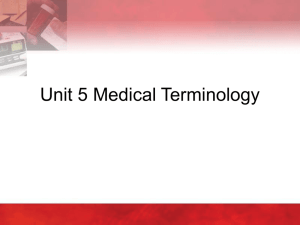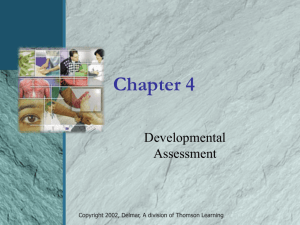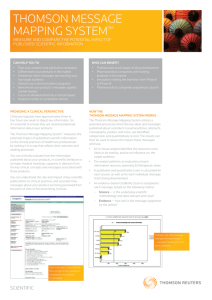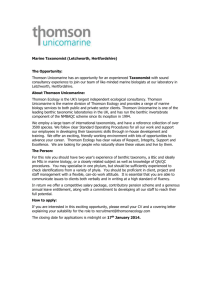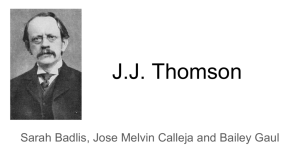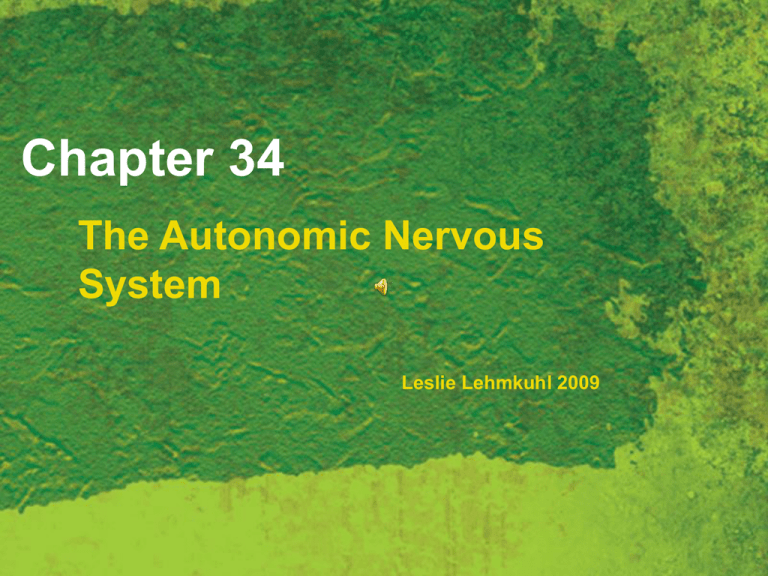
Chapter 34
The Autonomic Nervous
System
Leslie Lehmkuhl 2009
NEUROLOGICAL ASSESSMENT
History
Cerebral function..
Cranial nerve function
Motor function
Sensory function
Reflexes
34 - 2
Copyright 2007 Thomson Delmar Learning, a division of Thomson Learning Inc. All rights reserved.
Nursing assessment
History of incident or
accident headaches,
changes of vision,
seizure
activity,numbness or
tingling in an
extremity, mood
changes, personality
changes, fatigue,
pupil size and
reaction, level of
consciousness,
perception, speech,
lethargy, motor
coordination,
proprioception
34 - 3
Copyright 2007 Thomson Delmar Learning, a division of Thomson Learning Inc. All rights reserved.
Cerebral Function Assessment
Level of consciousness
(responsiveness and
orientation), most
important indicator in
changes of LOC..
1.
Call pt by name
2.
If no response…
touch pt gently or
shaking shoulder
3.
If no response….
use strong
stimulation (e.g. nail
bed pressure)
To document use
Glasgow Coma Scale
or document pts state
of arousal
Alert
Disorientation
Lethargic
Obtunded
Stuporous
Semiconcious
Comatose
34 - 4
Copyright 2007 Thomson Delmar Learning, a division of Thomson Learning Inc. All rights reserved.
Glasgow Coma Scale
Scale of responses to eye
opening, motor response
and verbal response with
a number for each.
Total ranges from 3 to 15
<7 is considered a
comatose state
It is important to monitor
any downward trend in
the patients score. If this
happens, the nurse must
act quickly, call MD and
assist with measures to
prevent or reduce ICP
and prevent further brain
damage..
34 - 5
Copyright 2007 Thomson Delmar Learning, a division of Thomson Learning Inc. All rights reserved.
Cerebral Function Assessment
Mental status (e.g., Mood,
behavior, facial
expressions, gestures)
Intellectual function (e.g.,
concentration and
recall)
repeating numbersrecall
adding small numbers calculation
last meal eaten
Short term
memory=repeating 3
numbers stating what
was eaten for last meal
Long term
memory=school
attended time served in
the military
concentration
general knowledge
repeating recent news
information
34 - 6
Copyright 2007 Thomson Delmar Learning, a division of Thomson Learning Inc. All rights reserved.
Cerebral Function Assessment
Emotional status
(affect).
Pupillary reaction
(size and
equality)
mydriasis
miosis
34 - 7
Copyright 2007 Thomson Delmar Learning, a division of Thomson Learning Inc. All rights reserved.
Cerebral Function Assessment
PERRLA:
Pupils
Equal
Round
Reactive
Accommodation
normal findings
Distance= dilation
Close up=
constriction
Brisk
Sluggish
Non-reactive
consensual
34 - 8
Copyright 2007 Thomson Delmar Learning, a division of Thomson Learning Inc. All rights reserved.
Cerebral Function Assessment
Oral and written
communication.
Vocabulary usedAphasia: no speech
Sensory aphasia:
Receptive aphasia
inability to
comprehend the
spoken or written
word
34 - 9
Motor aphasica:
Expressive aphasia
inability to use
words or symbols
Global aphasia:
inability to
understand the
written word or to
speak
Anomia: inability to
name objects
Dysarthria: difficult
Copyright 2007 Thomson Delmar Learning, a division of Thomson
Learning Inc. All rights reserved.
speech
Autonomic Nervous System
34 - 10
Neurotransmitter: is a
chemical substance
(agent) that excites,
inhibits or modifies the
response of another
neuron.
Neurotransmitters are
released in the
synapse in order to
carry impulse from one
neuron to another.
Includes two
neurotransmitters
Norepinephrine
Acetylcholine
(continues)
Copyright 2007 Thomson Delmar Learning, a division of Thomson Learning Inc. All rights reserved.
ANS (Two branches)
Sympathetic : Adrenergic
System
•
“fight or flight”
Parasympathetic
Cholinergic System
34 - 11
Copyright 2007 Thomson Delmar Learning, a division of Thomson Learning Inc. All rights reserved.
Sympathetic Nervous System
(Adrenergic Nervous System )
Stimulates vital organs
Suppresses nonvital body functions
Signs of stimulation of the SNS
Pupil dilation
Bronchiole dilation (opens airway)
Increased rate and force of contraction
Blood vessel dilation in muscle tissue
Increased breakdown of glycogen to glucose
34 - 12
Copyright 2007 Thomson Delmar Learning, a division of Thomson Learning Inc. All rights reserved.
The Autonomic Nervous
System Agents
Sympathetic nervous system receptors
Alpha
Found in smooth muscle tissue of peripheral
blood vessels and in the sphincters of the
gastrointestinal and genitourinary system
Beta
Found mainly in the heart, lungs,, and brain
•
•
•
•
Increase force and contraction of the heart
Increases ability of respiratory function (asthmatics to
open airways) B2
Shunt blood to major organs
Increase energy in the body
34 - 13
Copyright 2007 Thomson Delmar Learning, a division of Thomson Learning Inc. All rights reserved.
Parasympathetic Nervous System
(Cholinergic)
One neurotransmitter
Acetylcholine
Conserves energy
Promotes nutrient use
34 - 14
Copyright 2007 Thomson Delmar Learning, a division of Thomson Learning Inc. All rights reserved.
Drugs Affecting the ANS
Sympathomimetic: adrenergic drugs
Sympatholytic: adrenergic blocking
drugs
34 - 15
Stimulate the system by mimics the action
of the SNS (e.g. open airways)
Block alpha and beta receptors
(continues)
Copyright 2007 Thomson Delmar Learning, a division of Thomson Learning Inc. All rights reserved.
(continued)
Drugs Affecting the ANS
Parasympathomimetic: cholinergic drugs
Mimic the PNS
Parasympatholytic: anticholinergic drugs
Block acetylcholine receptors
34 - 16
Copyright 2007 Thomson Delmar Learning, a division of Thomson Learning Inc. All rights reserved.
Adrenergic Blockers
Treat
Hypertension
Migraine headache
Side effects/adverse effects
Hypotension
Dizziness
34 - 17
Copyright 2007 Thomson Delmar Learning, a division of Thomson Learning Inc. All rights reserved.
Adrenergic Blockers: Geriatric
Considerations
Increase sensitivity to adrenergic drugs
High R/F falls…
Monitor for:
Chest pain
Palpitations
Blurred vision
Headache
Seizures
Hallucinations
34 - 18
Copyright 2007 Thomson Delmar Learning, a division of Thomson Learning Inc. All rights reserved.
Cholinergics
Stimulate the PNS
Treat
Conditions with poor muscular contraction
Neurogenic bladder
Glaucoma
Cardiac arrhythmias
34 - 19
Copyright 2007 Thomson Delmar Learning, a division of Thomson Learning Inc. All rights reserved.
Cholinergics: Geriatric
Considerations
Increase sensitivity to cholinergic drugs
Monitor for:
Diarrhea
Increased bronchoconstriction
Increased bronchial secretions
Increased lacrimation
Blurred vision
34 - 20
Copyright 2007 Thomson Delmar Learning, a division of Thomson Learning Inc. All rights reserved.
Anticholinergics
Action
Decrease gastrointestinal and respiratory
secretions
Dilate bronchioles
Dilate pupils
Treat
Nausea
Urinary incontinence
Overactive bladder
34 - 21
Copyright 2007 Thomson Delmar Learning, a division of Thomson Learning Inc. All rights reserved.
Anticholinergics: Geriatric
Considerations
Increase sensitivity to anticholinergic
drugs
Hyperthermia
Urinary retention
Decreased appetite
34 - 22
Copyright 2007 Thomson Delmar Learning, a division of Thomson Learning Inc. All rights reserved.

